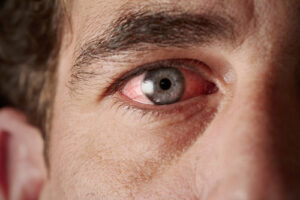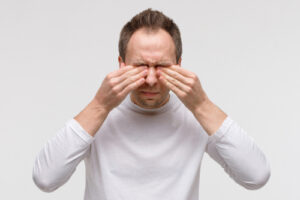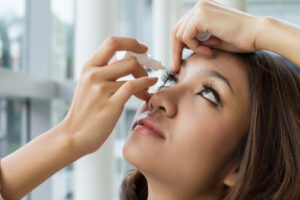If you’ve ever experienced the discomfort of dry eyes, you know how bothersome and persistent it can be. Many individuals mistakenly believe that dry eyes are only a seasonal nuisance, but in reality, this common condition can affect anyone throughout the year.
Understanding the underlying causes of dry eyes is key to finding relief and taking proactive steps to care for your eye health. Keep reading to learn more about dry eye, including why it isn’t seasonal!
What Causes Dry Eye?
Contrary to popular belief, dry eyes aren’t solely a seasonal problem. To find relief, it’s essential to grasp the root causes behind the condition.

In order to have a healthy cornea, which is the clear dome-like structure at the front of the eye, you must also have a healthy tear film. The tear film is a complex structure consisting of three layers: the watery, oily, and mucus layers.
This film works harmoniously to keep our eyes moist and maintain clear vision. Various factors can disrupt this delicate balance, contributing to persistent dry eyes throughout the year.
Environmental elements like dry air, windy weather, and air-conditioned environments speed up tear evaporation, leaving your eyes feeling dry and irritated. Lifestyle habits also play a significant role.
Spending extended periods on digital devices, not blinking enough, and wearing contact lenses excessively may reduce tear production and worsen dryness. Underlying medical conditions such as autoimmune disorders, allergies, and hormonal changes can also exacerbate dry eyes regardless of the season.
Are Dry Eyes Affected by the Seasons?
Although the condition persists throughout the year, certain seasonal factors can exacerbate dry eye symptoms. As the colder months settle in, both outdoor and indoor air tends to be drier due to heating systems.

This dry air can accelerate tear evaporation, leading to increased dryness and discomfort in your eyes. In contrast, during the warmer months, allergies can come into play and worsen dry eye symptoms.
Allergens like pollen and mold can trigger an inflammatory response in the eyes, reducing tear production and intensifying dryness. Remember, dry eyes can be affected by the seasons, but that’s not the whole story!
While chilly winters and blooming springs might bring some extra dryness, it’s essential to know that other factors also play a part. Your daily habits and even medical conditions can team up with the seasons to make your eyes feel less lubricated.
How to Differentiate Seasonal Discomfort from Chronic Dry Eyes
Distinguishing seasonal discomfort from chronic dry eyes is essential for determining the appropriate treatment. Seasonal discomfort often arises due to temporary environmental changes, like weather or allergens.
These brief episodes may cause temporary dryness and irritation. On the other hand, chronic dry eyes persist beyond seasonal variations and are often caused by a lack of tears or an unbalanced tear film.
Consistent symptoms, such as persistent dryness, grittiness, or fluctuating vision, may indicate a more chronic issue. If you notice frequent or ongoing discomfort, visit your eye doctor at Blaine Eye Clinic.
Your eye doctor can assess your symptoms, review your medical history, and conduct comprehensive tests to diagnose and differentiate between seasonal and chronic dry eyes. By identifying the root cause, you can receive tailored treatment and lifestyle recommendations to manage the condition effectively throughout the year, ensuring your eyes stay comfortable and healthy.
How Are Dry Eyes Diagnosed and Treated?
Dealing with dry eyes can be frustrating and uncomfortable, but there are ways to find relief. If you suspect you have dry eyes, some home remedies like staying hydrated, using a humidifier, or incorporating omega-3 fatty acids into your diet may help temporarily.
However, to get a comprehensive diagnosis and effective treatment, it’s best to visit your eye doctor for an evaluation. To diagnose dry eyes, your eye doctor may utilize diagnostic tests like TearLab to measure tear osmolarity to identify dry eye syndrome.

Another test your eye doctor may use is InflammaDry. InflammaDry detects elevated levels of MMP-9, an inflammatory marker linked to dry eyes.
For a broader treatment approach, your eye doctor may recommend OptiLight, an FDA-approved intense pulsed light (IPL) therapy. This non-invasive procedure targets inflammation, meibomian gland function, and tear film stability, providing lasting results.
Patients typically undergo four gentle sessions over two to four weeks, experiencing improvement by the second or third session. Talk to your eye doctor to explore if OptiLight is right for you and to develop a personalized treatment plan for relieving your dry eye symptoms effectively.
If your symptoms are seasonal, your eye doctor will likely recommend staying hydrated, using artificial tears, and protecting your eyes with sunglasses. Indoor humidifiers can help during colder months, and taking screen breaks reduces irritation.
Manage allergies and seek professional guidance if symptoms persist.
Are you experiencing symptoms of dry eyes? Schedule an appointment at Blaine Eye Clinic in Blaine, MN, today!





